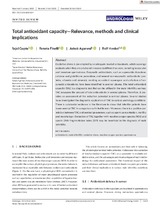| dc.contributor.author | Henkel, R | |
| dc.contributor.author | Gupta, S | |
| dc.contributor.author | Finelli, R | |
| dc.date.accessioned | 2021-05-11T12:12:56Z | |
| dc.date.available | 2021-05-11T12:12:56Z | |
| dc.date.issued | 2021 | |
| dc.identifier.citation | Henkel, R. et al. (2021). Total antioxidant capacity—Relevance, methods and clinical implications. Andrologia, 53(2),e13624 | en_US |
| dc.identifier.issn | 0303-4569 | |
| dc.identifier.uri | 10.1111/and.13624 | |
| dc.identifier.uri | http://hdl.handle.net/10566/6141 | |
| dc.description.abstract | Oxidative stress is pre-empted by an adequate level of antioxidants, which scavenge oxidants when they are produced in excess by different sources, including leukocytes and immature spermatozoa. Enzymatic antioxidants, such as superoxide dismutase, catalase and glutathione peroxidase, and several non-enzymatic antioxidants (proteins, vitamins and minerals), working as oxidant scavengers and cofactors of enzymatic antioxidants have been identified in seminal plasma. The total antioxidant capacity (TAC) is a diagnostic test that can be utilised in the male infertility workup. TAC measures the amount of total antioxidants in seminal plasma. Therefore, it provides an assessment of the reductive potential in seminal plasma. Several studies have investigated the diagnostic application of TAC in various andrology conditions. There is substantial evidence in the literature to show that infertile patients have lower seminal TAC in comparison with fertile men. | en_US |
| dc.language.iso | en | en_US |
| dc.publisher | Blackwell Publishing Ltd | en_US |
| dc.subject | Antioxidants | en_US |
| dc.subject | Male infertility | en_US |
| dc.subject | Oxidative stress | en_US |
| dc.subject | Reactive oxygen species | en_US |
| dc.subject | Spermatozoa | en_US |
| dc.title | Total antioxidant capacity—Relevance, methods and clinical implications | en_US |
| dc.type | Article | en_US |

